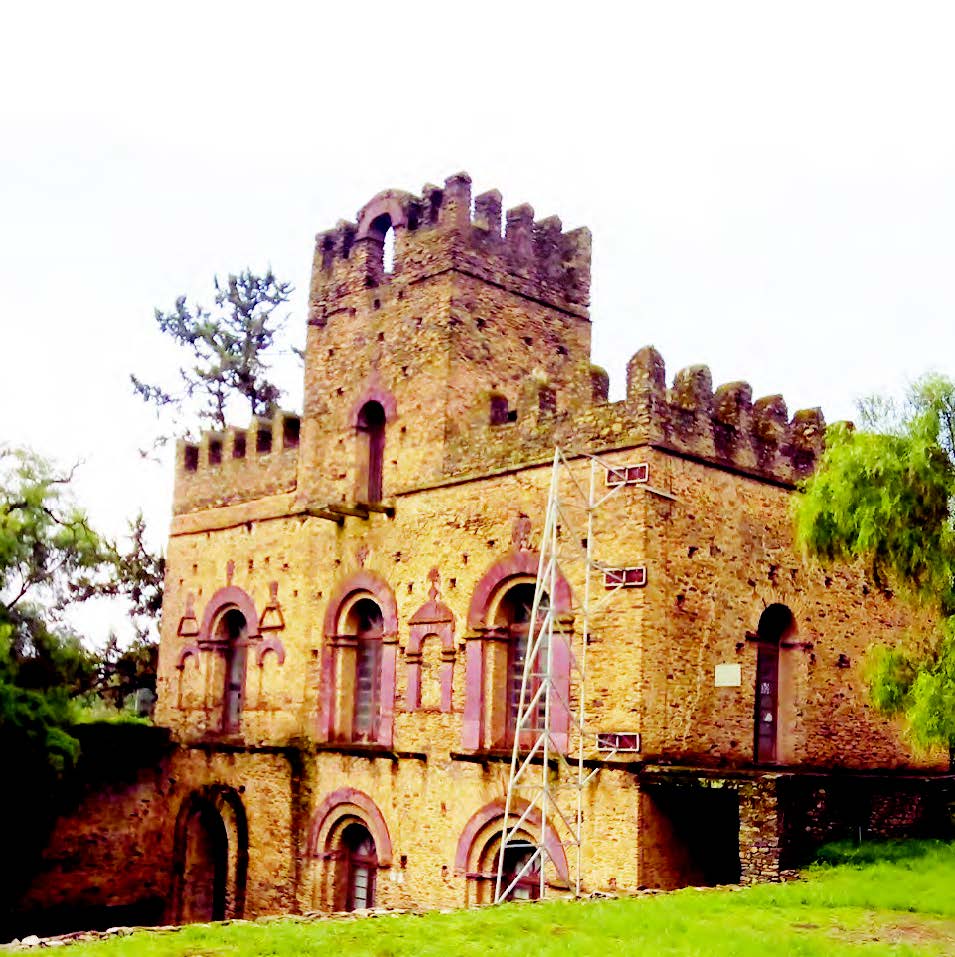“You are welcome to the ‘Camelot of Africa,” Aseged Tesfay, a tour guide addressed us with so much certainty and confidence that for a split second I doubted if I were in Gondar, Ethiopia.
The 5 feet-3inches Tesfay spoke about the sights we were about to see and how we were about to re-live history. His conviction was such that I felt he was about to lead us to the fictional ‘Camelot.’
Gondar is an old city located about 1,200 above sea level. During the medieval 17th century it served as the capital of both the Ethiopian Empire and the subsequent Begemder Province.

In modern times, it is located north of Tana, a two-hour drive across beautiful green scenery from Bahir dar,
Gondar is noted as a centre of ecclesiastical learning of the Ethiopian Orthodox Tewahedo Church, which is said to have as many as 44 churches.
Some of these churches can be sighted en route Gondar, usually distinguished by being located within thick vegetations that can be likened to a forest.
An official of the Ethiopian Tourism Organisation, Welde Gebriel Berhe, said the churches or monasteries in Ethiopia had won several “awards for environmental conservation as they are often located in wild landmass (forest) with a lot of trees and green areas.”
The surrounding countryside of Gondar constitutes the homeland of most Ethiopian Jews, or so it was before their mass exodus back to Israel, which took place in two major phases, Welde explained.
“Every monastery has a special day they go for celebrations annually, and several of the members walk long distances,” Gebriel said.
This was evident on that fateful Sunday. When we were approaching Gondar, people of all ages, from the very young to the old, clad in attires or wrapped with white veils, made the long walk to these churches – Coptic, orthodox – located in densely populated vegetations or around mountain tops.
Welde said they were clad or covered with white cotton veils because it’s believed that in the presence of God everyone is equal. As such, the tradition of using white attires stops the need to flaunt your wealth.

Tourists troop to the modern city of Gondar because of its many picturesque ruins in Fasil Ghebbi (the Royal Enclosure), from which the emperors once reigned.
The tour guide said that in the medieval era, between the 16th and 17th centuries, King Fasilidas chose Gondar, an obscure village, to be the site of his Empire’s new capital.
According to him, during that period a family was only allowed to dwell in a particular place for just seven generations, after which the eighth generation was expected to move and settle in another village. This practice was done for health reasons like preventing overcrowding, as well as political reasons.
For the royal family, each emperor or king is expected to build his/her own castle. This explains why the City of Gondar has about 20 palaces, royal buildings, highly decorated churches, monasteries and unique public and private buildings.
One of the foremost castles in the city is The Fasilides’ or the Fasil Ghebbi Palace, which consists of eight components within a 900-meter long wall, which are: the Castle of Emperor Fasilidas; the Castle of Emperor Iyasu; the Library of Tzadich Yohannes; the Chancellery of Tzadich Yohannes; the Castle of Emperor David; the Palace of Menteweb and Banqueting Hall of the Emperor Bekaffa.

One of the castles in the enclosure belongs to Fasilides, also known as Fasil, who lived between 1603 and 1667. Building the City of Gondar, which is now a United Nations Educational, Scientific and Cultural Organisation (UNESCO) World Heritage site, is commonly credited to him.
He became an emperor in 1632 and was a member of the Solomonic dynasty. His throne was known as Alam Sagad, meaning “to whom the world bows.’’
In the enclosure you can still see the remains of the Castle of Iyasu, commonly referred to as Iyasu the Great, whose throne was known as Adyam Sagad, meaning “to whom the confines of the earth bow.’’ He lived between 1654 and 1706 and was also a member of the Solomonic dynasty.


according to the rank of the owners while the right side is the palace
Another person in the line of the Solomonic dynasty, with a palace in the Fasil Ghebbi, was Bakaffa. His throne was known as Ama Giyorgis, and later, Masih Sagad, meaning “to whom the anointed bows.’’ He ruled between 1721 and 1730.
Bakaffa added several new buildings to the capital city of Gondar. He is credited with the construction of a vast banquet hall on the north side of the Royal Enclosure, which stands next to his wife, Mentewab’s Castle.
Empress Menteweb, according to our tour guide, was a woman widely respected for great “managerial skills.” After the death of Bakaffa, she was said to have helped the then 8-year-old Emperor Iyasu II to rule the empire with many positive results.

She also later assisted her grandson to rule. It was said that after she retired to a live in a monastery, the emperor deviated, and this ushered Gondar into the dark ages, Tesfay explained.
The palace is believed to have been built by Bakaffa’s son. It is one of the most beautiful palaces in the castle.
Throughout her stay in the enclosure, Mentewab was a major political figure during the reigns of her son, Emperor Iyasu and grandson, Iyoas.
The landscape of the Fasilades Castle is one that little is needed to use as a setting for a medieval movie or television series. The lush green plains against the medieval buildings provide a beautiful scenery. Newly wedded couples and their bridal entourages often take advantage of this for their wedding shooting.
Several of the castles have balconies on the upper floor, where the ruler stayed to address his subjects. “This is because there was no direct contact between the people and the king,” Tesfay said.
While showing us a place believed to have served as a restroom, the tour guide explained that the king’s toilet was called “Lion Seat.” This is because Ethiopian kings believe they are descendants of the Lion of Judah.
During festivities, the dining room for ladies is different from that of the men. The castles have several large rooms.

One of the delicacies of the time was raw meat. This habit was cultivated during a protracted religious war when they couldn’t cook as the smoke would give out the location of their hiding place on the mountains. They ate raw meat; and eventually, it became a tradition.
The royal enclosure also has a large water-stone reservoir, which was used to store water during the rainning season because Gondar had seven months of rain.
In the royal enclosure, there is also a building for sauna bath, which is informally referred to as the “Chicken House.” The bridges connecting the palaces are called the “Hats-off bridges.” This is because when the king passes by, the people remove their hats in greetings, our tour guide explained.
Not very far from the Fasilades palaces is the Debre Birhan Selassie Church, which was built by Emperor Eyasu II, also known as Birhan Seged: “He to whom the light bows.”
It was named Debre Birhan, “Mountain of Light,” after the emperor’s nickname.
The Debre Birhan Selassie (Trinity and Mountain of Light) Church in Gondar is famed for its beautiful examples of Ethiopian church art. Built by an emperor and preserved by an archangel, it is also among the most important churches of Ethiopia.

 According to a local legend, when the Mahdist soldiers approached the church, a swarm of bees protected it and kept the soldiers back. Archangel Michael himself stood before the large wooden gates with a flaming sword drawn.
According to a local legend, when the Mahdist soldiers approached the church, a swarm of bees protected it and kept the soldiers back. Archangel Michael himself stood before the large wooden gates with a flaming sword drawn.
The gates of the church is said to be constructed in the likeness of a crouching lion, and the fence is the tail. Inside the orthodox Coptic Church, the walls depict biblical scenes and saints while the ceiling is covered with the faces of hundreds of angels, side by side.
Icons of the Holy Trinity (three identical men with halos) and the crucifixion have pride of place above the entrance to the Holy of Holies.

According to one of the priests, the fence around the church has 12 pillars, with each representing one of the 12 apostles.
At a point in time, there were 3,000 Italians in Gondar, with about 30,000 registered to come in, but their failure to conquer Ethiopia led to a halt.
Till date, the influence of the Italians is still seen across Gondar. Administrative offices, banks, courts are still housed in Italian styled buildings. The restoration of the castles was also done in collaboration with them.
At the end of the tour, which included witnessing a Gondar Coptic wedding procession at the Debre Birhan Selassie Church, Tesfay asked if we enjoyed the experience at the “African Camelot.”
All photos by Bamas Victoria

 Join Daily Trust WhatsApp Community For Quick Access To News and Happenings Around You.
Join Daily Trust WhatsApp Community For Quick Access To News and Happenings Around You.


